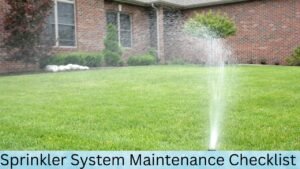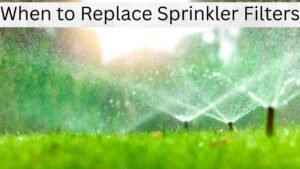Maintaining a lush and green lawn depends on more than watering—it requires a reliable irrigation setup. Many homeowners ask, how long do sprinkler systems last, and when should they think about replacement? This guide explains the average lifespan, the key factors that affect it, and the clear signs it’s time for an upgrade so you can avoid costly repairs and keep your lawn thriving.
Sprinkler systems can typically last between 15 to 20 years, but this lifespan can vary greatly depending on various factors like maintenance, climate, water quality, and system components. Knowing when to replace your system can save you money on repairs and water bills, while improving the health of your lawn.

How Long Do Sprinkler Systems Last? Understanding the Key Factors
A sprinkler system’s lifespan is influenced by several elements, from the quality of its components to the climate where it’s installed. Here are some critical factors that can affect how long your system will last:
An irrigation system is a long-term investment, but its lifespan depends on proper installation, maintenance, and water quality. Most systems last 15 to 25 years with regular care. As discussed in How Long Does an Irrigation System Last? – YouTube video below: TriState Water Works · 15 Jan 2024, timely repairs and upgrades can extend system performance well beyond the average.
1. Quality of Components
The materials and parts of your sprinkler system—such as pipes, sprinkler heads, valves, and controllers—affect how long the system will last. High-quality components, such as corrosion-resistant sprinkler heads or durable PVC pipes, can extend the life of the system beyond 20 years, while cheaper components may wear out much sooner.
2. Climate and Weather Conditions
Climate plays a major role in the wear and tear on your system. For example:
- Hard freezes can crack PVC pipes if they are not properly winterized.
- Intense UV radiation can degrade plastic components like sprinkler heads, causing them to crack or become brittle over time.
In extreme climates, your system may need more frequent maintenance or quicker replacement due to these environmental stresses.
3. Soil Type and Lawn Size
The type of soil and the size of your lawn also contribute to the lifespan of your sprinkler system. For instance:
- Clay soil retains moisture for longer but can cause compaction, which increases the workload on your system.
- Sandy soil drains water quickly, leading to more frequent use of the system.
Large lawns or complex landscapes with multiple zones require more advanced systems, which may need replacing sooner due to their complexity and increased wear.
Signs It’s Time to Replace Your Sprinkler System
Understanding when to replace your sprinkler system can save you costly repairs and water. Here are clear signs that indicate it’s time for a replacement:
1. Uneven Watering
- If your lawn is showing dry patches or signs of overwatering, it could be a sign that your system isn’t distributing water properly. Problems like clogged heads, low pressure, or leaks may be to blame.
2. Frequent Repairs
- If you’re constantly fixing sprinkler heads, valves, or pipes, it may be more cost-effective to replace the system entirely rather than continuing repairs. A system that breaks down frequently is a clear indicator it’s nearing the end of its lifespan.
3. Visible Leaks
- Leaks around sprinkler heads or exposed pipes not only waste water but also indicate that your system is deteriorating. If leaks are frequent and widespread, it might be time for a replacement.
4. Broken or Malfunctioning Heads
- Broken sprinkler heads that don’t pop up or spray erratically can reduce the efficiency of the system, leading to uneven watering and higher water bills.
How Maintenance Affects Lifespan
Proper maintenance can help extend the lifespan of your sprinkler system. Beyond basic checks, here are key tasks that should be performed regularly:
- Head Alignment: Ensuring sprinkler heads are correctly aligned for full coverage helps avoid inefficient watering and damage.
- Clearing Debris: Debris can clog nozzles, reducing water flow and system performance. Regular cleaning is crucial to maintaining system efficiency.
- Checking the Backflow Preventer: A properly functioning backflow preventer stops contaminated water from entering the potable water supply. Regular checks are necessary to ensure it’s working correctly.
- Flushing the System: Flushing your system regularly can help remove mineral buildup, especially if you have hard water that can cause corrosion and clog the system.
Neglecting these tasks will lead to premature wear and possibly the need for a full system replacement sooner than expected.
Smart Controllers and Water Savings
Smart irrigation systems are revolutionizing the way we water lawns by offering weather-based adjustments and zone control. Studies have shown that smart controllers can reduce water consumption by up to 30% or more, which not only conserves water but also helps prolong the lifespan of your system. These controllers can adjust watering schedules based on local weather conditions, preventing over-watering during rainstorms or drought periods.
Cost-Benefit Analysis: Repair vs. Replacement
It’s important to consider the long-term cost implications when deciding whether to repair or replace your sprinkler system. Here’s a rough breakdown of typical costs:
Common Repairs:
- Sprinkler head replacement: $5 – $15 per head
- Valve repair: $150 – $400
- Pipe replacement: $300 – $1,500 (depending on length and difficulty)
Full System Replacement:
- Average cost: $2,000 – $4,500 (depending on the size of the lawn and complexity of the system)
While repairs might seem cheaper initially, over time, constant fixes can add up. A new system, though more expensive upfront, could save money in the long run by improving water efficiency and reducing future repair costs.
Water-Saving Technologies in Modern Sprinkler Systems
Efficient water-saving technologies, such as drip irrigation, smart controllers, and low-flow sprinklers, reduce waste while keeping landscapes healthy. These solutions help homeowners cut costs and support sustainable water use. As highlighted in Use efficient water saving technologies – YouTube video below: EIACP Puducherry · 10 Oct 2023, adopting modern tools can make a big difference in conservation efforts.
Newer sprinkler systems are designed with water-saving technologies that can make a huge difference in both efficiency and lifespan. Some technologies to look for include:
- Drip zones: Ideal for garden beds, these systems deliver water directly to the roots, reducing evaporation and runoff.
- Soil moisture sensors: These devices measure soil moisture levels and adjust watering schedules accordingly, ensuring that your lawn isn’t overwatered or underwatered.
- Smart controllers: As mentioned earlier, these devices can adjust watering schedules based on local weather data, ensuring water is used only when necessary.
These technologies contribute to a more sustainable lawn care routine and can help extend the lifespan of your sprinkler system.
Winterization and Its Impact on Lifespan
Improper winterization is one of the leading causes of sprinkler system damage. In colder regions, pipes that aren’t properly drained or insulated can crack when water freezes inside them. This type of damage can lead to costly repairs and significantly shorten the system’s lifespan.
To avoid damage, make sure to properly winterize your system by draining the pipes, removing any water from the heads, and insulating exposed areas. If you’re unsure how to do this, it’s best to consult a professional.
When to Consult a Professional
While DIY maintenance can save money, there are situations where you should definitely call a professional:
- Electrical Issues: If your controller isn’t working or the wiring is faulty, it can cause major issues. Electrical repairs can be dangerous, so it’s best left to an expert.
- Main Water Line Problems: If you’re having trouble with water pressure or a pipe leak in the main line, a professional can help identify and fix the issue without causing further damage to the system.
- Complex System Issues: If your system has multiple zones, drip lines, or other advanced features, diagnosing and fixing problems may require expert knowledge.
The Future of Sprinkler Systems
The technology behind sprinkler systems is constantly evolving. With more efficient, smart, and environmentally-friendly systems on the market, future systems will likely last longer and provide even more value. Innovations in drip irrigation, solar-powered controllers, and automated system checks will help homeowners conserve water, reduce energy usage, and minimize the need for costly repairs.
Conclusion: The Long-Term Value of Sprinkler Replacement
Replacing an old, inefficient sprinkler system isn’t just about improving your lawn; it’s an investment in water conservation, cost savings, and property value. While systems typically last 15 to 20 years, regular maintenance, smart technology upgrades, and timely replacement can help your system run smoothly and efficiently for years to come.
The key takeaway is simple: don’t wait until your system fails completely—addressing replacement needs early can save you time, money, and frustration down the line. Plus, with new technologies constantly emerging, now might be the best time to upgrade to a more efficient system.





